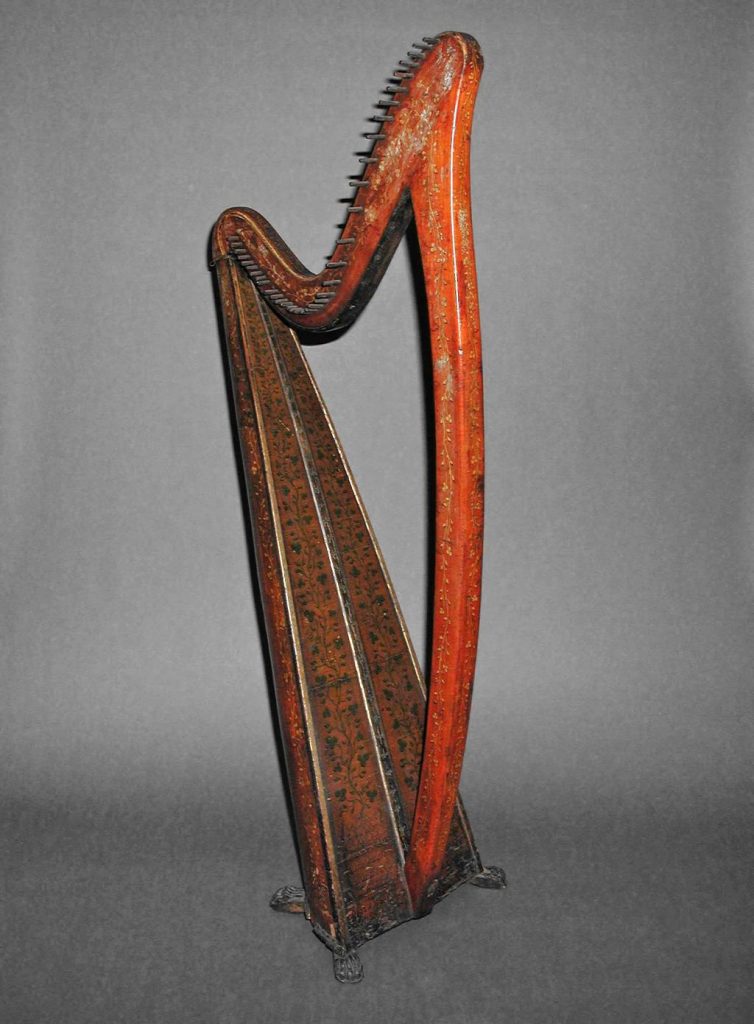Thomas Brown was a traditional Irish harper in the mid 19th century. This post is to collate the couple of references we have to him, to try and tell a bit of his life story.
I think we have just two different references for a traditional harper called Thomas Brown. Of course it is possible that they each refer to a different individual, but at this stage I am assuming the two references refer to the same person.
The sources
The first reference to Thomas Brown was printed in 1828, in the Irish Harp Society pamphlet which was printed in Calcutta for the Gentlemen in India who were bankrolling the Belfast harp school. It is a part of the excerpted minutes of the meeting of the Gentlemen of the management committee in Belfast on Thursday 24th August 1826
Ordered – That Thomas Brown, a blind boy, eleven years old, be received as an out Pupil, until a vacancy takes place, provided Mr. Rainey approves of his abilities.
Minutes of meeting, Thur 24 Aug 1826, printed in Irish Harp Society Calcutta 1828 (Penn Libraries ML1015.C3I7) p.44
The second reference was written down in 1908 by the Gaelic revivalist William Savage; it is part of a list of traditional harpers from the 19th century that was told to Savage by the harper and tradition-bearer George Jackson.
Tom Brown died Belfast was a Belfastman a good harper
National Museum of Ireland, Arts & Industry division, Archive File AI.80.019
died from a wetting coming from England to Belfast
Perhaps in or after 1911, Savage made a neater expanded version of the list (also in the same archive file), but the only change to Tom Brown’s entry is that he paraphrased “Belfastman”: “Born in Belfast and died in it”.
Putting the story together
We are told that Thomas Brown was aged 11 in August 1826, so he must have been born in the second half of 1814 or the first half of 1815. We are told that he was born in Belfast. He was either born blind, or perhaps more likely became blind as a child.
At the age of 11, he must have received a reference or recommendation to the Harp School in Cromac Street, and made his application.
For some reason, the Gentlemen’s decision to admit Tom Brown to the school is made subject to the approval of the teacher, Valentine Rennie. It is not clear to me why Tom Brown was singled out in this way, unless it is just an oddity of the minutes, and Rennie always had the last word.
When Tom Brown joined the school in August 1826, there were already five resident boarding pupils there: Alex Jack, Martin Crenny, Arthur Morgan, John McMullan, and Matthew Wall. There were also four day pupils who are not named in the minutes. And there were also two other new boys who were also admitted in August 1826 alongside Thomas Brown, Thomas Williamson (who was recommended by an important Gentleman), and Michael McClosky (whose friends had to pay for his schooling). I’m not sure about McClosky, but certainly Williamson and Brown were admitted as day pupils for the time being, until two of the boarders finished their education so that Williamson and Brown could take their places.
So we can imagine Valentine Rennie, and his wife Mary Ann, and the five boarding boys, all living in the house in Cromac Street. And then every day, the six or seven day pupils (including Tom Brown) would walk in to the house for their lessons.

Valentine Rennie had learned to play the traditional Irish wire-strung harp from the harper Arthur O’Neil in about 1809-11. We don’t have a lot of information about how Rennie taught or what the curriculum was like, though we do have some of the harps that were used in the school. These are the big floor-standing traditional wire-strung Irish harps that were made for the Irish Harp Society by the Dublin harpmaker, John Egan. These harps have 37 brass wire strings.
Unfortunately we don’t have any more records from the Irish Harp Society management committee after Thomas Brown entered the school in August 1826, for the time he was there. We have a brief note about his classmate Matthew Wall being discharged and given a gift harp, in 1830, but at the moment we can’t say anything about how long Tom Brown was a pupil, or when he might have been discharged, and presumably given a harp and a certificate by the Society, and sent off into the world to make his living as a traditional musician.
We also don’t have any information about his career, but we can assume that he had a career, because George Jackson tells us that Tom Brown was a good harper. I think that George Jackson’s information was mostly about people who were perhaps a generation older than him, and I think that everyone he mentioned was a traditional harper playing probably as a full time professional on traditional wire-strung Irish harp.
The kinds of work that Tom Brown may have done are things like playing every evening in a tavern or restaurant; playing for private dinners for clubs or associations; playing for private events for wealthy aristocratic or middle class patrons; or busking in the streets or parks.
We know that Thomas Brown went to England. He may have gone to play at an event; we have references to Irish harpers in a few places in England, including Jackson in London, Byrne in Leamington and Hampshire, and Begley who went to live in Yorkshire.
We have an intriguing reference to a St Patrick’s Day dinner in Liverpool, on Tuesday 17th March 1846. There was a full report of the dinner published in the local newspaper, but unfortunately for us it does not name the harper. It just says
…at the top of the centre table sat the chairman, and behind him was seated a harper, dressed in ancient costume. He was a portly-looking personage, looked well, and managed his part very efficiently…
Liverpool Mercury, Fri 20 Mar 1846 p7
… A band of instrumental music occupied the front seat in the gallery, and, alternately, with the harper on the stage, played the choicest national and inspiring airs…
I really don’t know who this harper was. If we look at my timeline we can see that in 1846 there were perhaps 30 or so traditional harpers in Ireland. It is possible that this was Tom Brown in Liverpool; and if it was not, it can nonetheless give us a sense of the kind of work he might have been doing.
We are told that Tom Brown died in Belfast, “from a wetting coming from England to Belfast”. It is not clear entirely what this means. Obviously Tom Brown was riding the boat west across the Irish sea, and somehow got wet, and then died after he had arrived in Belfast. I suppose the most likely place he was coming from was Liverpool, but it is possible he was coming from a different port such as Heysham or Whitehaven. He also may have been working somewhere else in England such as London. I suppose it is even possible that he was actually coming back from Scotland or Wales, and Jackson just got the countries garbled; I don’t know how reliable George Jackson’s information about that kind of thing might have been. I have come across a few Irish people who say “England” when they mean “Britain”.
What does the “wetting” refer to? Did he catch a cold from being caught out in the rain? Or did he fall overboard, like Gillespie?
I have not found a record of his death, either in the newspapers or in the death records. The Irish death records only start in 1864 so it is quite likely that Thomas Brown died before then. I will keep hunting in the newspaper archives and we may yet find a brief death notice.


Wonderful and informative Simon as always. Thank you so much.
Many thanks Simon